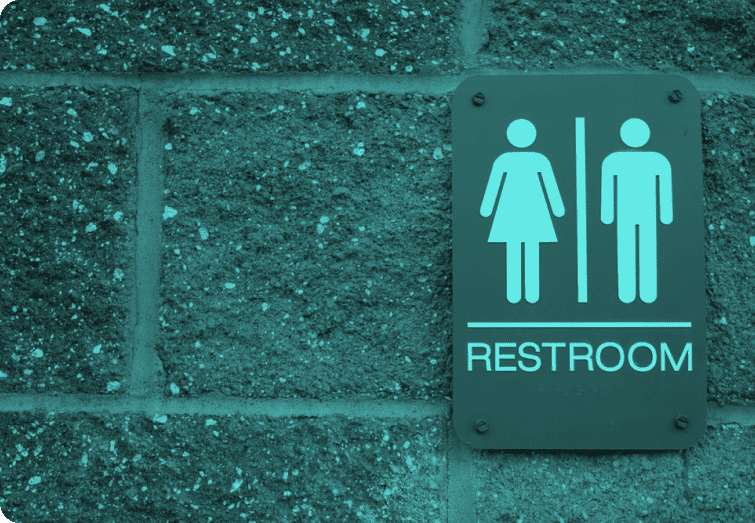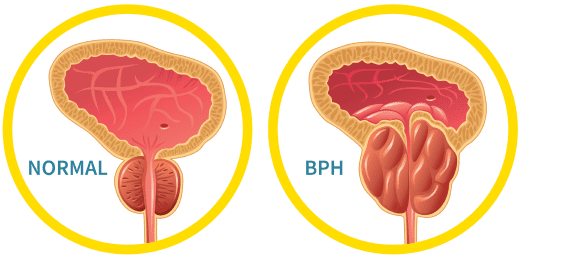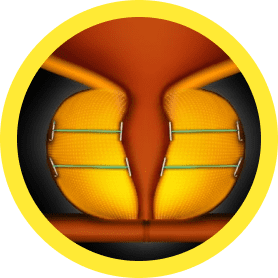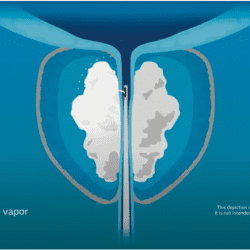Treatments for BPH in Dallas-Fort Worth
Is BPH the Bane of Your Day?
Age brings wisdom, but it also brings physical changes that can be a nuisance. For many men, an enlarged prostate turns a common body function into a problem that interferes with almost every aspect of daily life.
An urgent need to go, urinating more often, a weak stream, trouble starting and stopping—these are some of the most common symptoms of benign prostatic hyperplasia (BPH).
From prescription medications that treat mild-to-moderate symptoms to minimally invasive procedures and surgical treatments, Urology Partners offers a variety of treatment options for BPH.

Bigger Isn’t Always Better
As men age, their prostate grows. In some men, the prostate can grow up to five times its normal size. In others, it doesn’t grow very much at all. While BPH is commonly thought of as an “old man” problem, about 20 percent of men in their 40s and 60 percent of men in their 60s show evidence of BPH. For men in their 70s and 80s, the stats shoot up to 90 percent.
What Causes BPH?
In a healthy prostate, the urethra (the narrow tube that carries urine from the bladder and out of the body) runs unobstructed through the middle of the prostate. This makes it easy to eliminate urine. When the prostate becomes enlarged, it presses on the urethra and urine has a harder time passing through the prostate.

The blockage slows or even cuts off urine flow—causing annoying symptoms that often make it difficult to get a good night’s sleep, play a round of golf, travel, enjoy dining out and or a movie other activities. Days and nights revolve around being near a bathroom at all times.
Here’s the good news: Urology Partners of North Texas offers the latest minimally invasive treatments for long-lasting relief from BPH symptoms. We help men get back to doing all the things they love without worry or embarrassment. Talk to one of our BPH specialists to see which treatment option is right for you.
Health Navigator
Related News & Information
Life After the Lift (UroLift) is Great!
For many men, an enlarged prostate can make life miserable. The urgent need to go, urinating more frequently than normal, a weak urinary stream, difficulty starting and stopping—they’re all symptoms of BPH. Find out how the UroLift is helping men get their life back.
Ready to Wave Goodbye to Erectile Dysfunction?
Erectile dysfunction complicates the sex lives of many men—millions, in fact. Yes, ED is frustrating and embarrassing. It can even be depressing. But there’s one thing it’s not—inevitable.
Several Factors Guide Treatment
From prescription medications that treat mild-to-moderate symptoms to minimally invasive procedures and surgical treatments, Urology Partners offers a variety of treatment options for BPH.

Medications
There are a variety of prescription medications designed to treat mild to moderate symptoms of BPH, including:
Alpha blockers relax muscles in the prostate so urinating is easier. If the prostate is not very large, alpha blockers work quickly. Alpha blockers can help up to two-thirds of men, although some men are not responsive to these medications.
5-alpha reductase inhibitors shrink the prostate, but can take anywhere from six months to two years before results take effect. This medication is only helpful for large prostates, and can cause sexual side effects such as decreased ejaculate volume and erectile dysfunction in some men.
Combination drug therapy uses both alpha blockers and 5-alpha reductase inhibitors together to treat symptoms and the cause of BPH simultaneously.
Tadalafil (Cialis) can help alleviate symptoms of BPH and erectile dysfunction when given in a daily dose.
UroLift®
When is going all the time going to stop controlling your life?
UroLift® is a minimally invasive procedure that doesn’t require any cutting, heating or vaporizing of prostate tissue. Routinely performed in an office setting under local anesthesia, an endoscope is used to access the prostate so a permanent implant can be placed. The implant holds enlarged tissue out of the way so it doesn’t block the urethra. Because prostate tissue isn’t damaged, recovery time is much faster, and men don’t experience the sexual side effects that can follow a transurethral resection of the prostate (TURP) such as low-volume ejaculation or no ejaculation. Men routinely begin seeing improvement in the first few weeks after the procedure.


Rezūm Therapy
Rezῡm Water Vapor Therapy uses the natural energy stored in water droplets to relieve the symptoms of BPH. During this minimally invasive outpatient procedure, a small device is inserted into the prostate through the urethra. The device delivers water vapor directly into enlarged prostate tissue. Thermal energy from the water vapor kills enlarged prostate cells. The office procedure takes only a few minutes, and most men see a dramatic improvement in their symptoms within the first few weeks to months after the procedure.
Laser Turp
Laser transurethral resection of the prostate (TURP)—also known as laser vaporization—removes excess tissue from inside the prostate to create an open channel that allows urine to flow from the bladder to the urethra.
An endoscope equipped with a laser is inserted through the tip of the penis and into the urethra. The laser vaporizes the inside of the prostate and removes any obstruction that prevents urine flow from the bladder to the urethra. The outside of the prostate remains intact. With laser TURP, there is routinely less bleeding and faster recovery than a traditional TURP. Men can usually go home the same day, and typically only have to wear a urinary catheter overnight or a few days.
Although there are several lasers designed for destroying prostate tissue, Urology Partners currently offers the GreenLight laser and Thulium laser. While both offer excellent destruction of prostate tissue, the choice of laser used is at the surgeon’s discretion. It should be noted that laser vaporization does result in decreased ejaculation fluid after the procedure (a side effect that is also associated with a traditional TURP). Men with larger prostates who may not be good candidates for minimally invasive treatment options such as UroLift or Rezῡm, may be better candidates for laser TURP or traditional TURP.


Traditional Turp
Meet Our BPH Experts
The UroLift® Center of Excellence designation is a coveted credential only bestowedupon providers with the highest level of training and experience.

Life After the Lift (UroLift) Is Great!
Every year, nearly 38 million men visit their doctors looking for help for their BPH symptoms. Read why so many are choosing the minimally-invasive UroLift—a procedure that doesn’t require cutting, heating or removal of prostate tissue.









